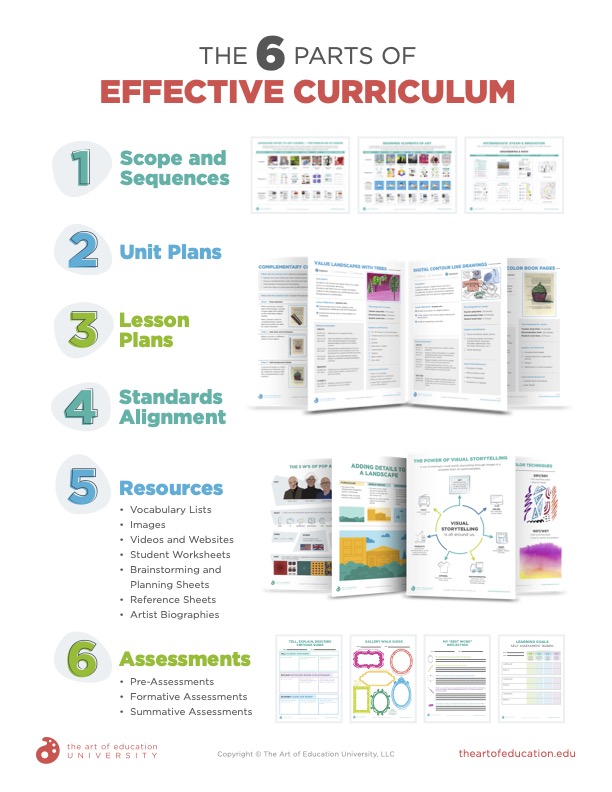The world of online art curricula is vast and varied. On the one hand, you may be overwhelmed with all of the choices and have difficulty deciphering what distinguishes one over another. On the other hand, you may be frustrated because most of what you find caters to parents, homeschool settings, or informal art instruction. But how do you vet your options for K–12 art curriculum? We want you to fully understand your options.
Read on to understand what to look for in an art curriculum.

What is a “complete” curriculum?
First, let’s examine what constitutes a “complete” curriculum. A complete curriculum serves a wide range of students and includes resources beyond lesson plans. It is aligned to standards and is created, curated, and vetted by a group of experts in the field. A complete curriculum can not only enhance your students’ art experience but can also build a strong foundation for your art program.
When evaluating to see if a curriculum can work for you, look for these six things to ensure you will have everything you need:
- Scope and Sequences
A map that shows all of the lessons and major ideas taught in a school year or for the duration of a course. - Unit Plans
A unit plan is an overarching organizational tool that groups lesson plans together, usually by theme. - Lesson Plans
Lesson plans include the following components: the time required, standards, objective(s), cross-curricular connections or areas of study, vocabulary, materials and supplies, instructional strategies, activity/project steps, differentiation and accommodations, resources, and assessment and reflection. - Standards Alignment
Standards can be state, local, and/or national. They reflect best practices and current thought in art education and are developed by experts. They ensure your lessons are on target and age-appropriate. - Resources
These can make the classroom experience come alive! They can include vocabulary lists, images, videos, websites, worksheets, planning sheets, reference sheets, artist biographies, and more. - Assessments
Formative assessment occurs during instruction and is ongoing. Summative assessment occurs at the end of instruction and is a one-time measurement. Both confirm that students are understanding and meeting the lesson objectives.
Download our 6 Parts of Effective Curriculum for a handy checklist to help you remember all six components as you search for curriculums or make your own. For more resources like this and a more in-depth look at what makes a strong curriculum, refer to our PRO Pack, The Building Blocks of Effective Curriculum. Look for this Pack in PRO Learning to learn more.
Download Now!
To show you what vetting curriculum looks like in practice, we’ve used AOEU’s FLEX Curriculum as an example. Let’s take a closer look.
The Art of Education University’s FLEX Curriculum (K–12)
The Art of Education University’s FLEX Curriculum is a flexible curriculum aligned to all 50 states’ visual art standards, including the NCAS. FLEX includes thousands of lesson plans, resources, videos, assessments, and artist bios that can be filtered and searched so you can find exactly what you need.

Scope and Sequences/Unit Plans
FLEX offers premade Scope and Sequences to save you time. Scope and Sequences are organized by grade level into units based on the NCAS. If you are someone who likes customization, the My Classes feature allows you to build your units and share them with other FLEX subscribers. FLEX is designed to integrate seamlessly with major learning management systems (LMS). FLEX even has units and lesson plans designed for substitutes!
Lesson Plans
FLEX lesson plans include everything you need to get started immediately, including key objectives, teaching strategies, step-by-step instructions, and more. Lessons are categorized into flexible bands, Beginner (elementary), Intermediate (middle school), and Advanced (high school), so you can choose the lessons that best fit your students’ needs.
Standards Alignment
FLEX Curriculum is aligned to all 50 states’ visual art standards, including the NCAS. Even better, you can filter FLEX materials by the NCAS or your state standards.
Resources
FLEX also comes with student-facing resources to support your teaching, including worksheets, reference materials, lists, graphic organizers, writing supports, and planning sheets. You can also help students connect to art concepts and diverse historical, contemporary, and living artists with FLEX videos and artist bios.
Assessments
FLEX includes a plethora of assessments to meet your students’ needs. Choose from various formative and summative assessments, including reflections and critiques.
Interested in learning more?
FLEX Curriculum is regularly purchased for art teachers by districts and schools. Fill out this quick contact form, and we will connect you with someone who can help! If you want to purchase FLEX on your own, you can subscribe monthly with the ability to cancel anytime. Or, sign up for the annual membership to receive two months free.
The Art of Education University also offers many other supports to art teachers. PRO Learning is an on-demand PD platform broken down by topic into Packs. Each Pack has several tutorial and training videos as well as downloadable resources. It is the perfect compliment to FLEX. Don’t miss the free resources available in the online Magazine and on YouTube.
Make your life easier!
Online art curricula subscriptions are an excellent option to guide or enhance the scope and sequence of your instruction. With various curricula options at your fingertips, it’s essential to understand which one will best meet the goals and standards your district requires. Likewise, platform compatibility and user-friendliness are vital to consider before investing in a subscription. Using an online art curriculum can make your life easier, so be sure to download and use the checklist above to help you select the best option for your practice.
What components do you look for in an art education curriculum?
How do you guide or enhance your scope and sequence?
Magazine articles and podcasts are opinions of professional education contributors and do not necessarily represent the position of the Art of Education University (AOEU) or its academic offerings. Contributors use terms in the way they are most often talked about in the scope of their educational experiences.






